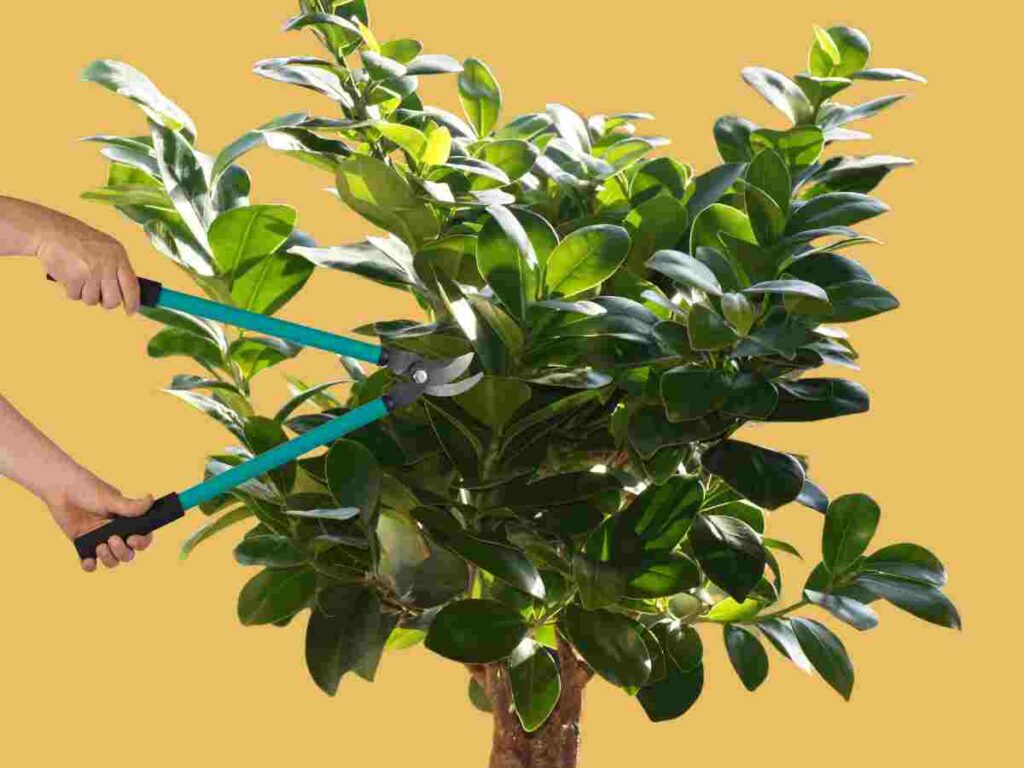If you don’t know how to Prune Ficus Ginseng Bonsai, need more guidance, or are afraid to prune but your ficus ginseng bonsai is looking tattered or ugly, don’t worry; I’ve got a cover.
Today’s post discusses pruning the Ficus ginseng bonsai and other related questions, such as when, how, how often, the best techniques needed, etc.
Specifically, we will look at three techniques to keep it thick and give the plant the desired shape to look like a miniature tree.
Let’s start immediately without wasting any more time.
Why Is It Necessary To Prune Ficus Ginseng?
Pruning a plant is used for training, shape maintenance, cutting dead branches, and maintaining the development of the foliage by limiting its vertical or outward growth.
Depriving the plant of apical dominance forces it to concentrate its energies on the lower and internal branches so that they become thicker and more vigorous.
These branches would dry out over time precisely because of the apical dominance, which pushes the plant to grow upwards in search of light. And not to strengthen and grow as compactly as we want.
The second purpose of pruning is to give the ficus the desired shape, maintaining only the pre-established branches to direct development in that direction.
In summary, we can say that pruning the Ficus microcarpa aims to keep the foliage compact and in a beautiful shape so that it resembles a small tree in a smaller version as much as possible.
To achieve this result, you need to use various pruning techniques that are very simple and accessible to everyone.
When Should I Prune Ficus Ginseng?
Maintenance pruning of Ficus ginseng can be done throughout the vegetative period, usually from May to October.
This minimally invasive technique is repeated several times throughout the growing season.
In the case of more invasive interventions, which involve cutting large branches.
Pruning is necessary towards the beginning of spring or late autumn when the plant is not in active growth.
Formative pruning is done one-off or every year as the plant grows and the shape evolves.
Defoliation must be done between June and July and only on healthy and vigorous specimens.
What Are The Pruning Techniques?
This technique determines the type of pruning you want to carry out, depending on the state of your plant.
Is your ficus filled with dead branches? Has the leaf outgrown its standard shape, or do you want to keep it in shape? Then, determine the techniques to use.
It is time to introduce you to the following article, which discusses how to prune a bonsai tree.
In that article, you will get in-depth information on different techniques, types of pruning, and how to do it quickly.
If you’re interested in reading, click read now to kickstart your journey in pruning bonsai.
Let’s quickly see what techniques to use.
Maintenance pruning
Maintenance pruning involves cutting young branches (shoots) that grow out of their original or desired shape.
Usually, the branches that grow vertically and towards the outside of the foliage are pruned.
Once approximately 6-7 leaflets have developed on the remaining twigs, proceed with trimming.
That is, the vegetative apex is removed to stop growth in length.
Regularly Repeating this process forces the plant to redirect the sap toward the primary branches and new nodes.
The growth becomes more homogeneous and well-distributed, and the foliage becomes denser.
Training pruning
Training pruning is used to give the Ficus bonsai the desired shape.
Since the intervention is usually carried out on more prominent and already lignified branches, the plant must be given time to grow before proceeding.
Once the foliage has expanded, it is necessary to prune the branches of the Ficus ginseng that grow out of the pre-established shape.
Instead, the vegetative apex must be trimmed from the remaining branches to promote lignification and redistribute growth.
If large branches are pruned, spreading grafting putty on the lesion is best to speed up healing.
Defoliation
Defoliation is a bonsai pruning technique. Techniques are used when we want to remove the
Removing the leaves (leaving the petiole intact) in some plant areas so that the energy is moved to the places we intend to develop.
It can also be used on the entire foliage to stimulate the development of fine twigs and smaller leaves.
What Is The Ficus Ginseng Bonsai Pruning Equipment?
The items needed to prune ficus ginseng consist of sharp and disinfected pruning tools like a cutter, knife, or scissors.

The home remedy for disinfecting this blade is to use alcohol, bleach, or sanitizer to kill any infection. Burning the blade is also helpful for killing infections.
Pruning putty must be applied to the lesions during interventions on large branches to promote faster healing and lower the possibility of bacterial or fungal infections.
How Do I Prune A Ficus Ginseng Bonsai?
Firstly, map out the branches you want to cut and the ones you want to leave.
Once you know the one to cut off, everything will be more accessible, and you will look concentrated.
Subsequently, we remove the dry branches because they are useless and unsightly.
This gives the plant a tidier appearance and gives us a better view of the remaining branches.
At this point, the actual pruning begins, which can take place differently depending on the size of the plant and the time that has passed since the last cut.
To advance your knowledge on pruning a bonsai tree step by step, click here.
What Happens If I Don’t Prune My Ficus Bonsai?
If you refuse to prune your bonsai, the three will grow out of shape and vertically, making it look unpleasant.
Without proper pruning, a bonsai will look like a regular tree because a bonsai needs to be in shape. Click here now to read about bonsai.
The branches become very long, creating thin and sparsely vegetated secondary ramifications. The foliage appears poor and messy.
When Should I Prune My Ficus Tree After Purchasing It?
The timing of the first pruning intervention varies depending on the size of the plant and its foliage.
If the foliage is limited and small compared to the wood, it is best to wait a few months before removing the cuttings.
For larger or well-vegetated specimens, you can start as soon as they acclimate to the new environment.
Conclusion
Decide immediately on the shape you want to give to the plant so you will have no doubts about where to cut.
And don’t be afraid to prune; if the ficus is healthy and receives the proper care, it will take little time to recover.
If you are interested in learning more about the topic, I recommend you read this article on pruning Ficus benjamina; READ NOW.





